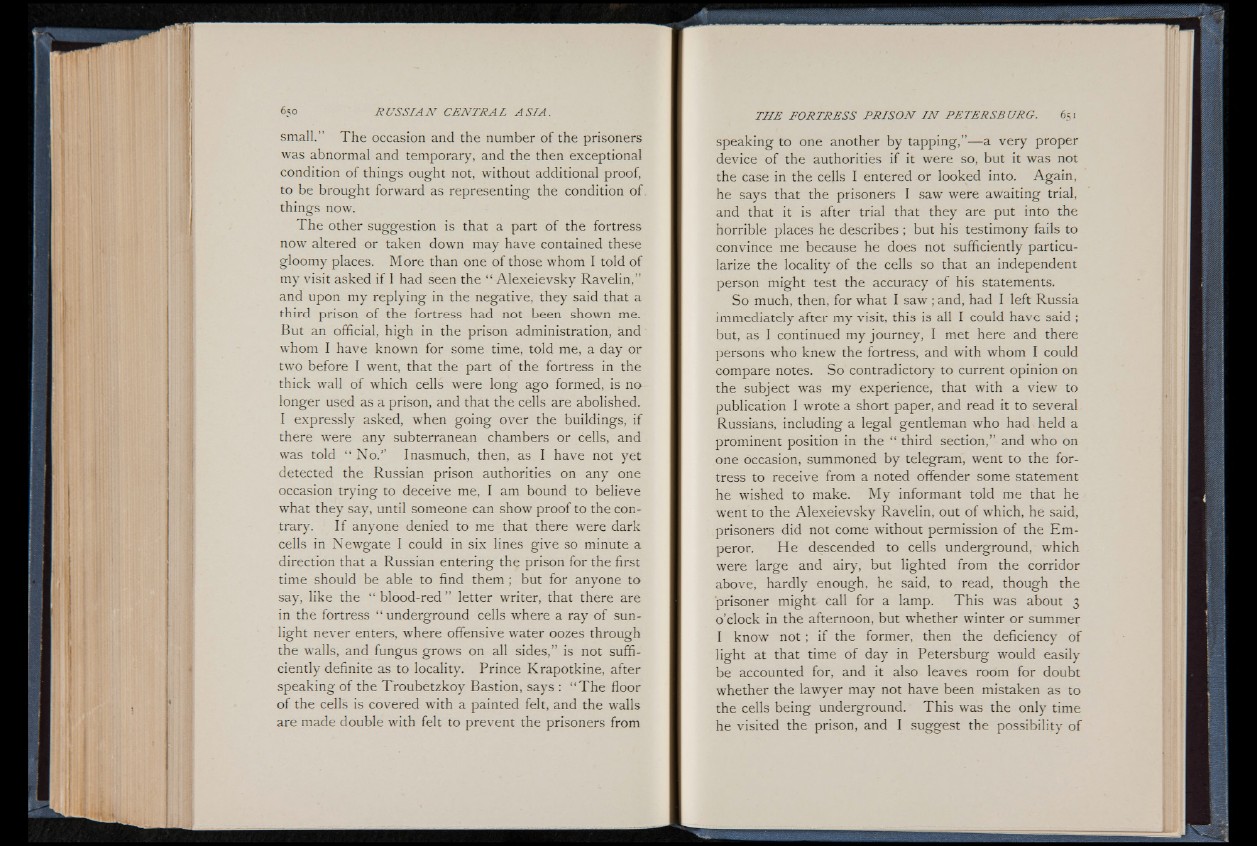
small.” The occasion and the number of the prisoners
was abnormal and temporary, and the then exceptional
condition of things ought not, without additional proof,
to be brought forward as representing the condition of
things now.
The other suggestion is that a part of the fortress
now altered or taken down may have contained these
gloomy places. More than one of those whom I told of
my visit asked if 1 had seen the “ Alexeievsky Ravelin,”
and upon my replying in the negative, they said that a
third prison of the fortress had not been shown me.
But an official, high in the prison administration, and
whom I have known for some time, told me, a day or
two before I went, that the part of the fortress in the
thick wall of which cells were long ago formed, is no
longer used as a prison, and that the cells are abolished.
I expressly asked, when going over the buildings, if
there were any subterranean chambers J or cells,7 and
was told “ No.” Inasmuch, then, as I have not yet
detected the Russian prison authorities on any one
occasion trying to deceive me, I am bound to believe
what they say, until someone can show proof to the contrary.
I f anyone denied to me that there were dark
cells in Newgate I could in six lines give so minute a
direction that a Russian entering the prison for the first
time should be able to find them; but for anyone to
say, like the “ blood-red ” letter writer, that there are
in the fortress “ underground cells where a ray of sunlight
never enters, where offensive water oozes through
the walls, and fungus grows on all sides,” is not sufficiently
definite as to locality. Prince Krapotkine, after
speaking of the Troubetzkoy Bastion, says : “ The floor
of the cells is covered with a painted felt, and the walls
are made double with felt to prevent the prisoners from
speaking to one another by tapping,”— a very proper
device of the authorities if it were so, but it was not
the case in the cells I entered or looked into. Again,
he says that the prisoners I saw were awaiting trial,
and that it is after trial that they are put into the
horrible places he describes ; but his testimony fails to
convince me because he does not sufficiently particularize
the locality of the cells so that an independent
person might test the accuracy of his statements.
So much, then, for what I saw ; and, had I left Russia
immediately after my visit, this is all I could have said ;
but, as I continued my journey, I met here and there
persons who knew the fortress, and with whom I could
compare notes. So contradictory to current opinion on
the subject was my experience, that with a view to
publication I wrote a short paper, and read it to several
Russians, including a legal gentleman who had held a
prominent position in the “ third section,” and who on
one occasion, summoned by telegram, went to the fortress
to receive from a noted offender some statement
he wished to make. My informant told me that he
went to the Alexeievsky Ravelin, out of which, he said,
prisoners did not come without permission of the Emperor.
He descended to cells underground, which
were large and airy, but lighted from the corridor
above, hardly enough, he said, to read, though the
prisoner might call for a lamp. This was about 3
o’clock in the afternoon, but whether winter or summer
I know not ; if the former, then the deficiency of
light at that time of day in Petersburg would easily
be accounted for, and it also leaves room for doubt
whether the lawyer may not have been mistaken as to
the cells being underground. This was the only time
he visited the prison, and I suggest the possibility of